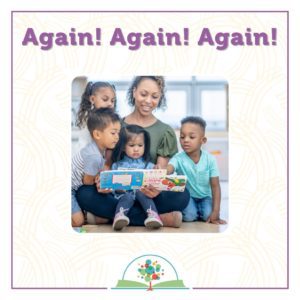24 Jan Again! Again! Repetition and Reading
 Does your child ask you to read them the same book over and over and over and over again, until you want to roll your eyes and beg them to choose something – anything – else?
Does your child ask you to read them the same book over and over and over and over again, until you want to roll your eyes and beg them to choose something – anything – else?
While it might be tempting to steer them to something new, repetitive reading has great value for children.
What is your child doing when you read them a book they have already heard read a dozen – or a hundred – times?
A lot!
Increasing Vocabulary
Books introduce children to many new words and concepts, and children need time to process these as they work toward understanding what they mean. Children hear the words in the context of a sentence, with visual cues to give them hints about meaning. The more times a child hears those new words and concepts as the book is read again and again, the more accurately they are able to make sense of them.
Noticing Details
In addition to the words of a story, the pictures and illustrations in a book provide a rich world for children to explore. Each time they look at a page, children may notice something new or different – the facial expressions of a character, a detail in the background of the setting, a favorite color or shape, or an object that they have just learned to identify.
Repetition allows children to deeply observe the visual aspects of a book, making connections between what they see and hear in the story with how they experience the world around them. Pictures also help them develop their vocabulary, as mentioned above. Some children may excitedly share what they notice, while others may silently take in their observations; regardless, they are paying close attention.
Putting It Together
Children are just beginning to make sense of the world around them: why things happen, what feelings are, how to cope with new situations. Nonfiction books provide facts that can help children directly understand such things, while fiction books can offer nuance and application through compelling stories.
When children hear the same book read many times, they can reflect on things like cause-and-effect, different ways feelings can be expressed, and typical reactions to different experiences. The more times they hear a fiction story, the more deeply they understand what’s happening in it and why. The more times they hear a nonfiction book read to them, the more information they retain.
Enjoying the Familiar
Sometimes a child may have heard the same book read so many times we think they can’t possibly learn anything new from it. Surely they know the meaning of every word, have seen every detail in every picture, and could summarize the plot and recite it back – maybe even word for word.
While there are probably always new things to observe, sometimes the predictability of a familiar story is comforting for a child. They know what to expect; their brain no longer has to work so hard to understand words and figure out what’s happening; they can simply rest in enjoyment of a good book they know they like. Who doesn’t appreciate that?
All of this holds true as children become more independent readers as well; they are still doing all of these things as they reread a book on their own, whether for the second or twenty-second time.
So the next time your child pulls that same book from the shelf for what feels like the millionth time, embrace it. Know that they are doing a lot of great work that will help them grow and learn and love to read!
Books that are fun to read repeatedly:
Pete the Cat: I Love My White Shoes by Eric Litwin
Little Blue Truck by Alice Schertle
Brown Bear, Brown Bear, What Do You See? By Bill Martin
Links to learn more:
https://cli.org/2016/03/07/benefits-of-repeated-read-alouds/



